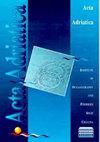Non-indigenous cephalopods in the Mediterranean Sea
IF 0.6
4区 生物学
Q3 MARINE & FRESHWATER BIOLOGY
引用次数: 7
Abstract
The present review critically assesses the records of cephalopods that have entered the Mediterranean Sea in the last few decades. It includes 13 species, namely Sepia dollfusi, Stoloteuthis leucoptera, Sepioteuthis lessoniana, Architeuthis dux, Cranchia scabra, Taonius pavo, Megalocranchia sp., Teuthowenia megalops, Cycloteuthis sirventi, Taningia danae, Octopus cyanea, Amphioctopus sp. and Tremoctopus gracilis. The presence of Sepia pharaonis needs to be confirmed, whereas that of Sepia gibba and Spirula spirula is excluded. The arrivals from the Atlantic Ocean through the Strait of Gibraltar are related to the entrance surface current, which either carried passively planktonic paralarvae or favoured in some other way the entrance of subadult and adult stray specimens. As a matter of fact, all Atlantic cephalopods are pelagic oegopsid squids, with the exception of the nekto-benthic sepiolid S. leucoptera; all of them have been found only in the western Mediterranean basin. None of them seemingly established a stable population there, apart from the latter species. On the contrary, the cephalopods entering the Mediterranean from the Red Sea through the Suez Canal (Lessepsian migrants) lead a benthic mode of life. At least two of them, namely S. lessoniana and Amphioctopus sp., set up stable populations in the eastern basin. Lastly the occurrences of the pelagic octopod T. gracilis are ascribed, in the literature, to human-mediated transfer.地中海的非本地头足类动物
本综述对过去几十年来进入地中海的头足类动物的记录进行了批判性评估。包括13种,分别是:dolfusi Sepia、Stoloteuthis leucoptera、Sepioteuthis lessoniana、Architeuthis dux、Cranchia scabra、Taonius pavo、Megalocranchia sp.、Teuthowenia megalops、Cycloteuthis sirveni、Taningia danae、cyanea Octopus、Amphioctopus sp.和Tremoctopus gracilis。法老Sepia pharaonis的存在需要确认,而棕腹Sepia gibba和螺旋藻Spirula Spirula则被排除在外。从大西洋经直布罗陀海峡而来的鱼类与入口的表层洋流有关,这些洋流要么被动地携带浮游幼虫,要么以其他方式有利于亚成虫和成虫的散失标本的进入。事实上,大西洋所有的头足类动物都是远洋的卵足类鱿鱼,只有底栖的卵足类鱿鱼除外;它们都只在西地中海盆地被发现。除了后一种物种外,它们似乎都没有在那里建立起稳定的种群。相反,从红海经苏伊士运河进入地中海的头足类动物(莱塞普西亚移民)过着底栖动物的生活。其中至少有两种,即S. lessoniana和Amphioctopus sp.,在东部盆地建立了稳定的种群。最后,在文献中,远洋章鱼T. gracilis的出现被归因于人类介导的转移。
本文章由计算机程序翻译,如有差异,请以英文原文为准。
求助全文
约1分钟内获得全文
求助全文
来源期刊

Acta Adriatica
生物-海洋与淡水生物学
CiteScore
1.60
自引率
11.10%
发文量
13
审稿时长
>12 weeks
期刊介绍:
Journal "Acta Adriatica" is an Open Access journal. Users are allowed to read, download, copy, redistribute, print, search and link to material, and alter, transform, or build upon the material, or use them for any other lawful purpose as long as they attribute the source in an appropriate manner according to the CC BY licence.
 求助内容:
求助内容: 应助结果提醒方式:
应助结果提醒方式:


